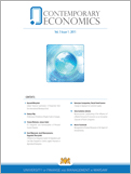Empirical Assessment for Driving Forces of CO2 Emissions: Application of STIRPART Model on the Leading ASEAN Countries
Empirical Assessment for Driving Forces of CO2 Emissions: Application of STIRPART Model on the Leading ASEAN Countries
Author(s): Harin Tiawon, Irawan Itta, . MiarSubject(s): Energy and Environmental Studies, Environmental and Energy policy, International relations/trade, Accounting - Business Administration
Published by: Akademia Ekonomiczno-Humanistyczna w Warszawie
Keywords: CO2 emissions; STIRPART model; panel data modelling; pooled OLS;
Summary/Abstract: The aim of this empirical research study is to investigate the effect of different driving forces of the CO2 emission for a set of leading ASEAN countries. The sample for this purpose included leading ASEAN countries; Indonesia, Thailand, Malaysia, Singapore, the Philippines and Myanmar due to the availability of the data from year 1992 to 2016. The study used panel data modelling techniques, such as fixed effect regression estimation, random effect regression estimation, as well as the pooled ordinary least square method of estimation. The dependent variable of the present study was CO2 emissions while the independent variables were Total Population, GDP per capita, Urban Population, Environmental tax, Environmental patent count and CO2 intensity. The study used a total number of three models for estimation purpose. Model 1 validated fixed effect estimation after conforming the significant value of Hausman test. Model 2 validated random effect estimation after conforming from LM test while pooled OLS was applied in case of Model 3. The findings of the study suggested that GDP as a proxy of affluence and environmental patent count as a proxy of technology are the important driving factors of CO2 emissions in the ASEAN region. The findings of the current study are generalizable on the other countries of the same region and are affective for the policy makers to enlighten their ideas for making affective policies at national and international level for controlling the CO2 emissions. The future researchers are advised to include more countries in the panel to strengthen the generalizability of the data as well as extent the STIRPART model as per the requirements of their studies.
Journal: Contemporary Economics
- Issue Year: 14/2020
- Issue No: 4
- Page Range: 453-465
- Page Count: 13
- Language: English

